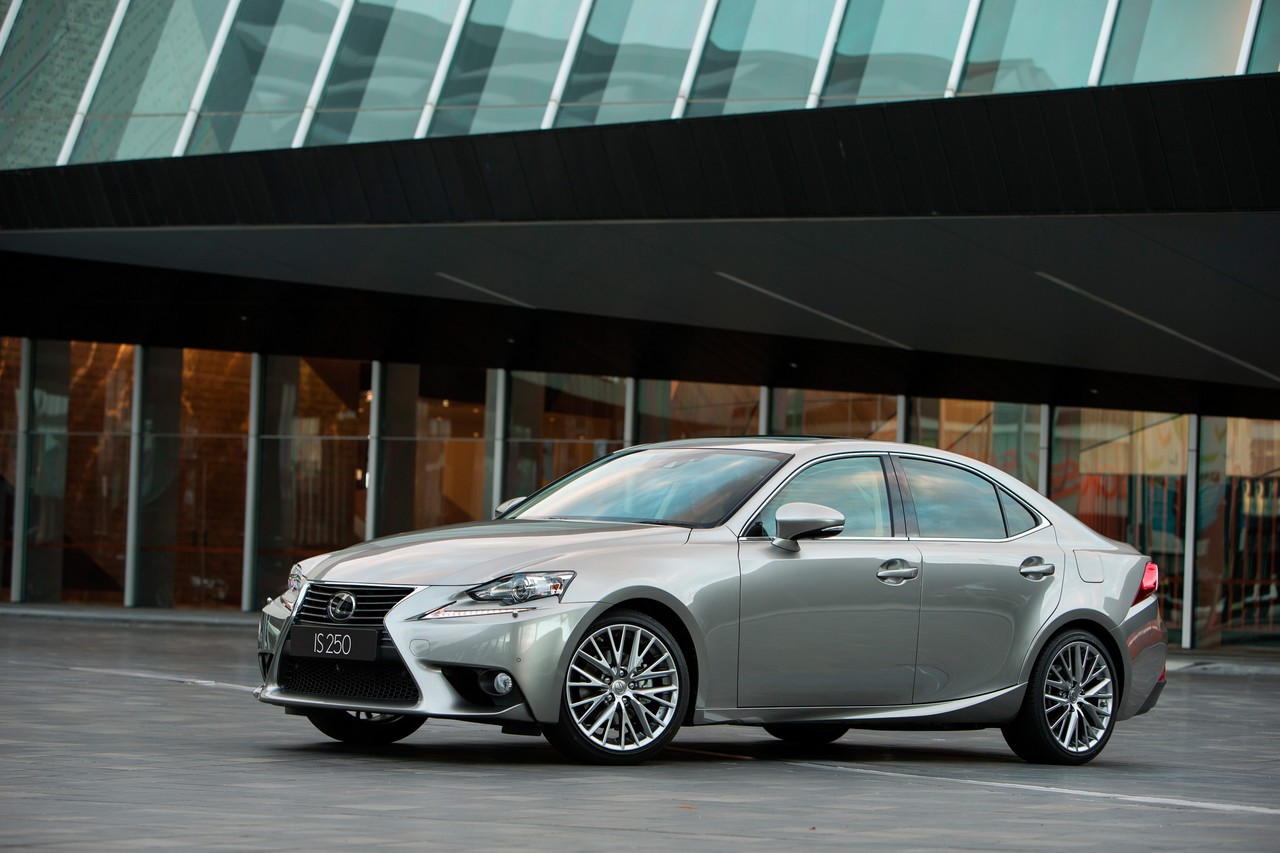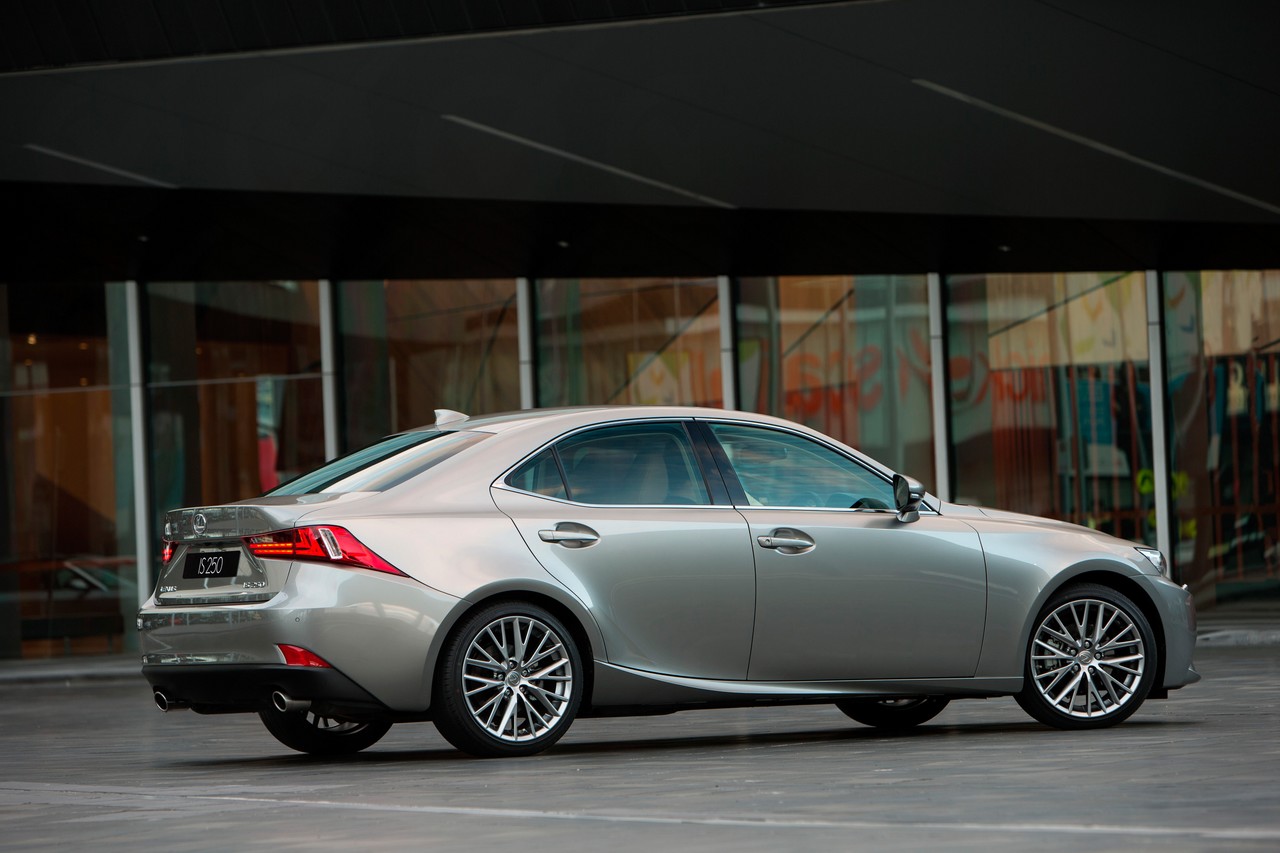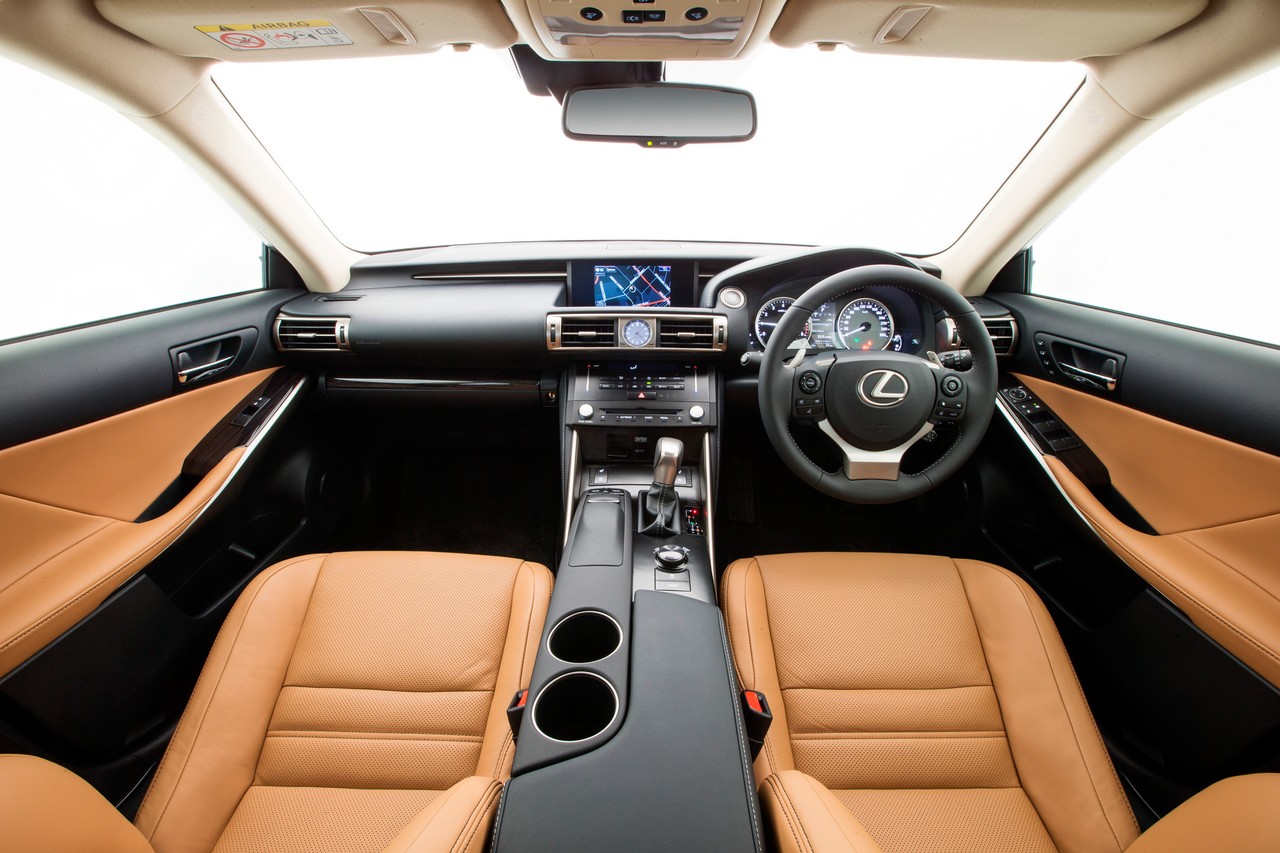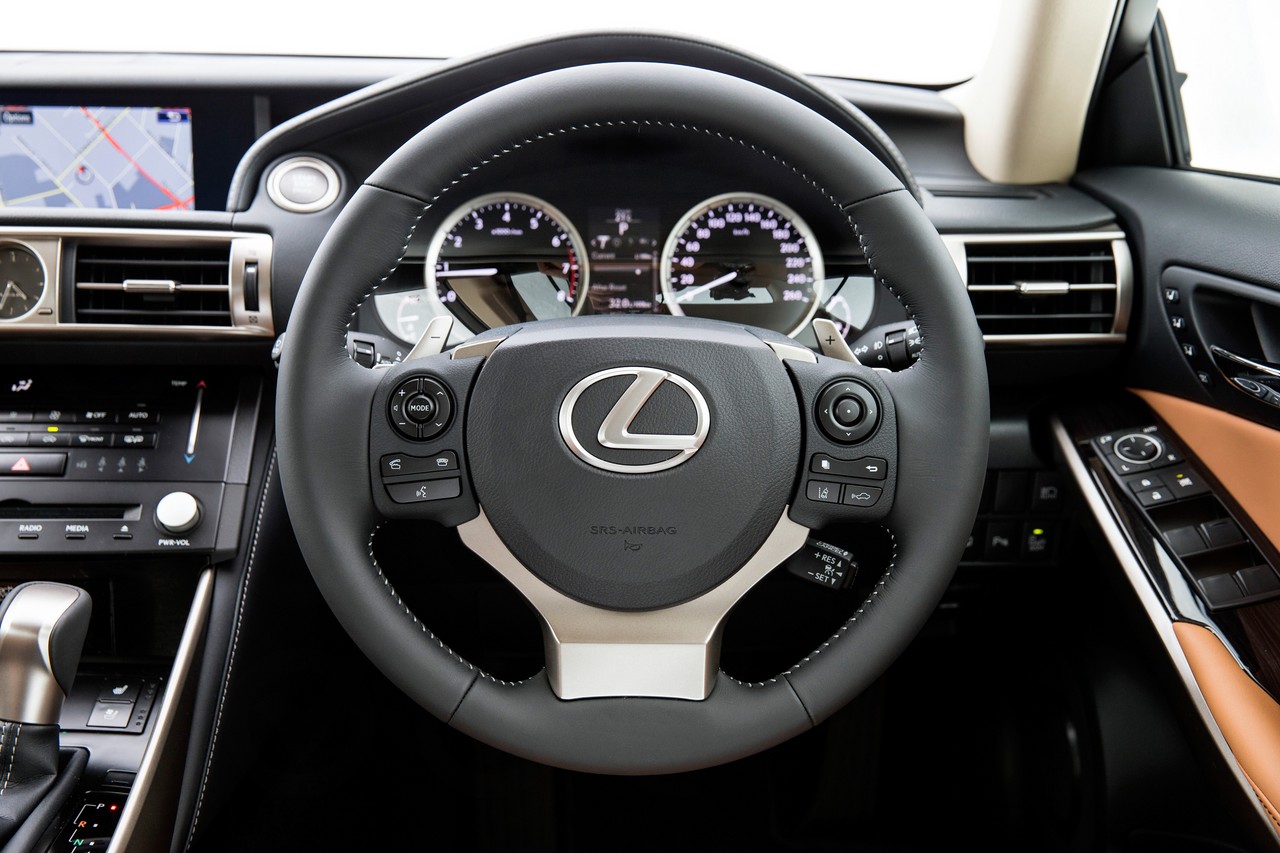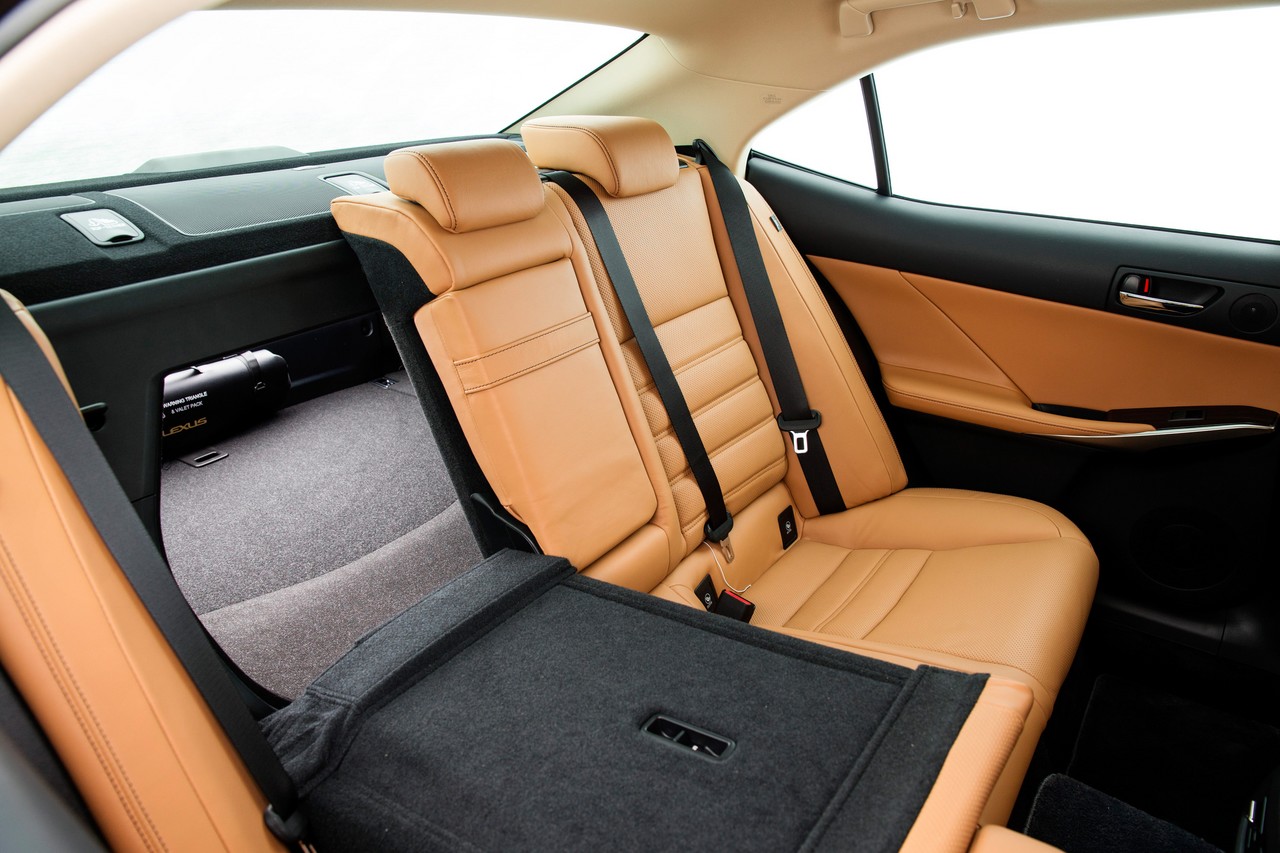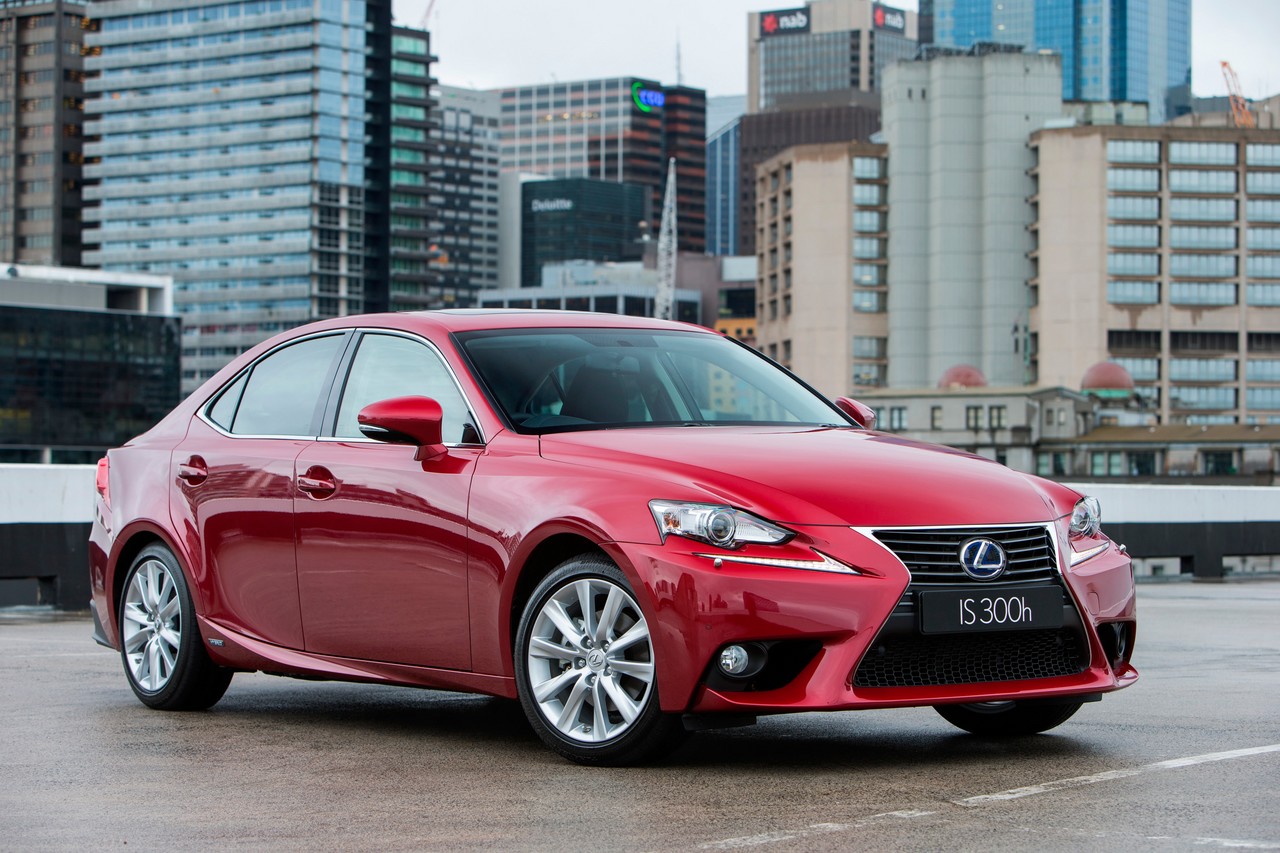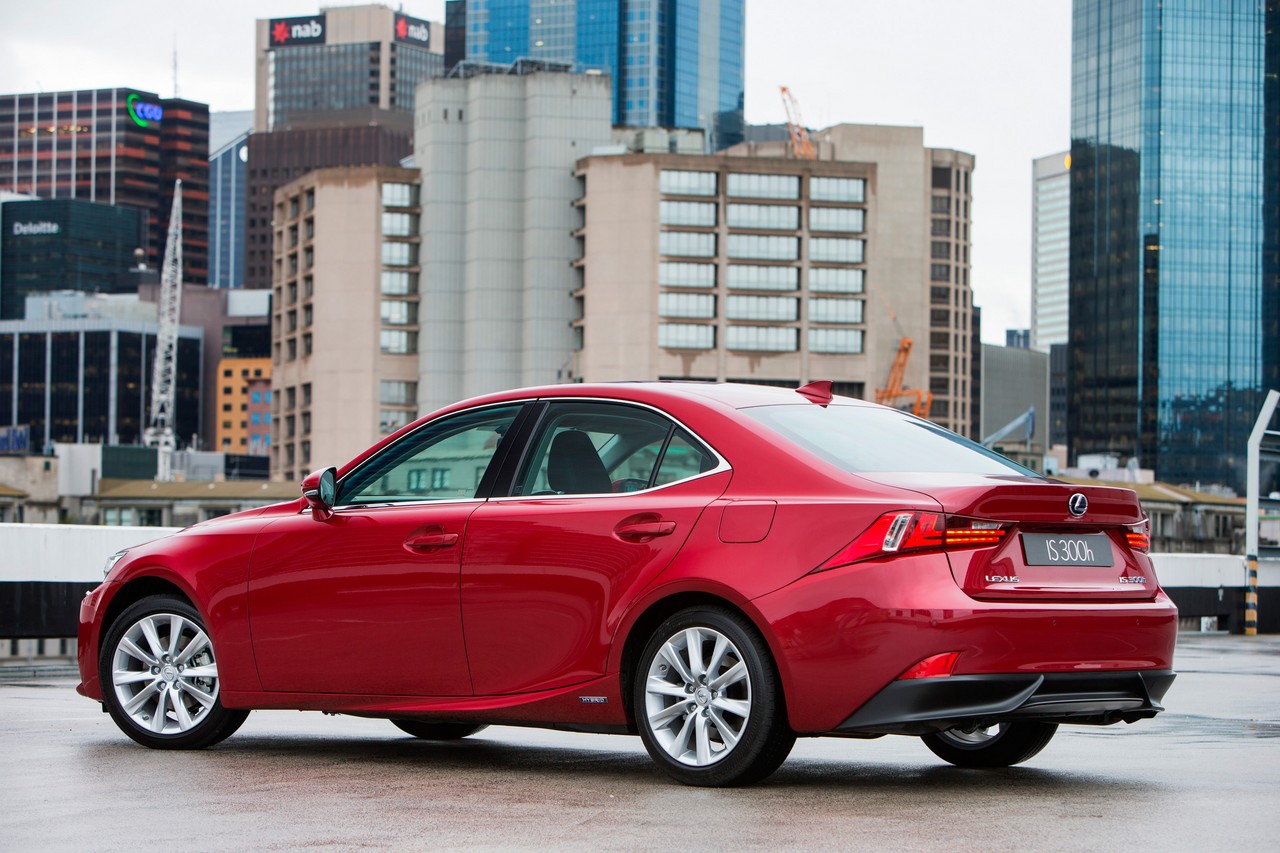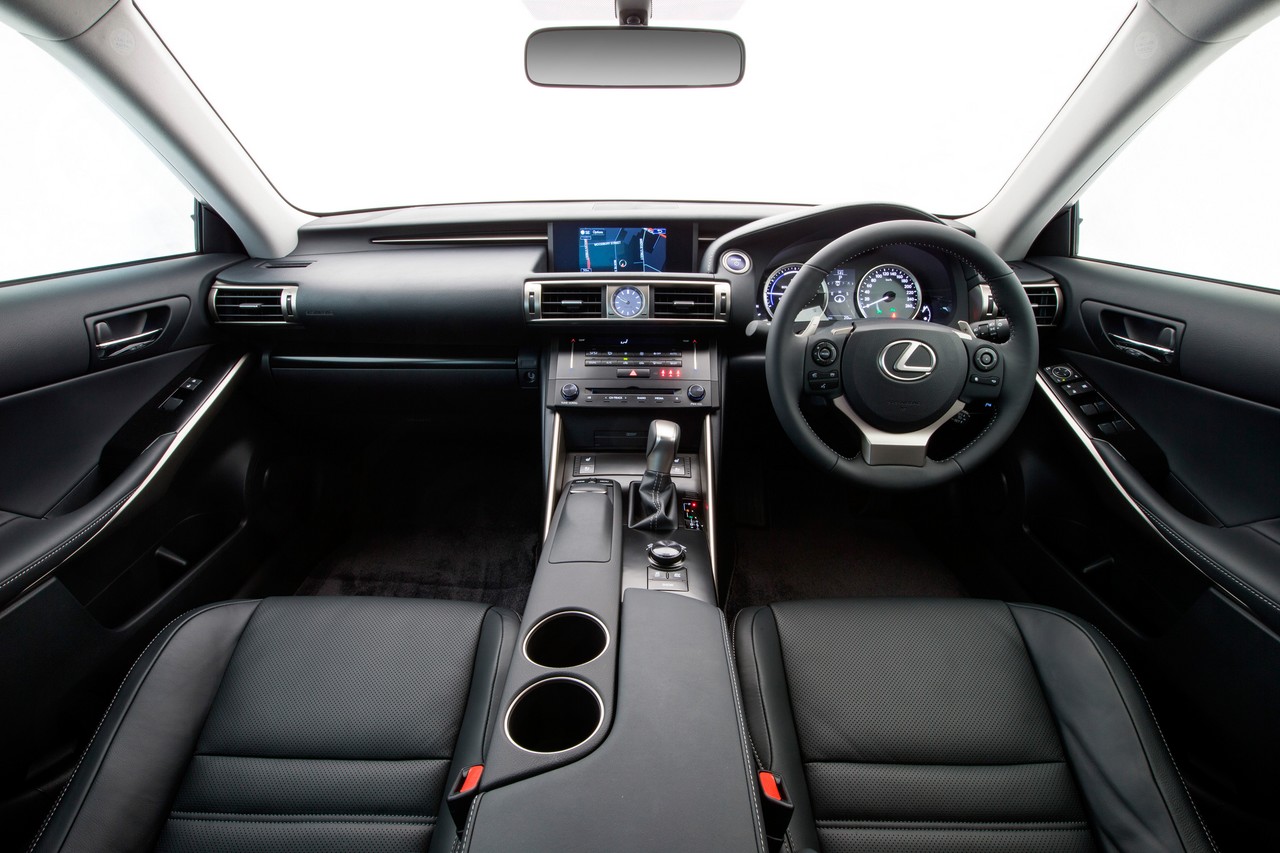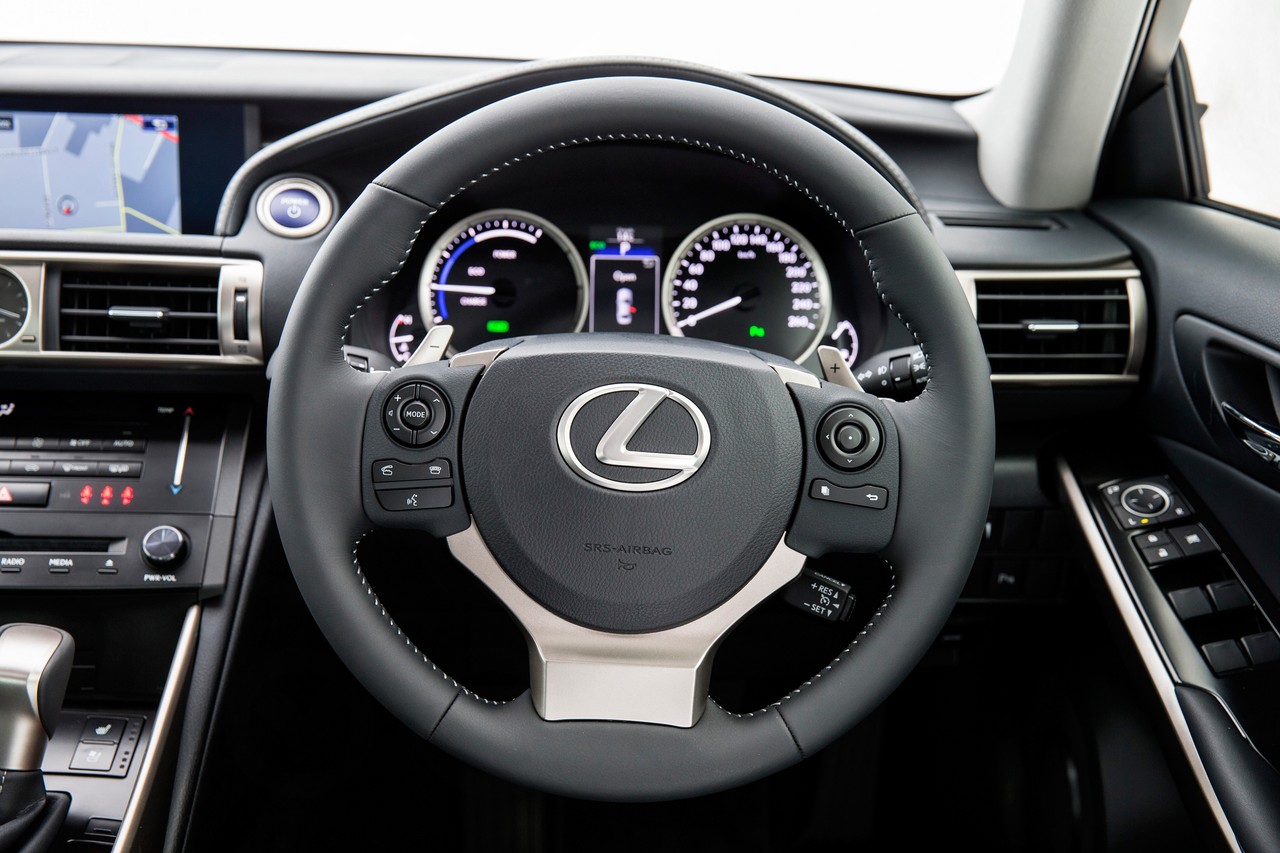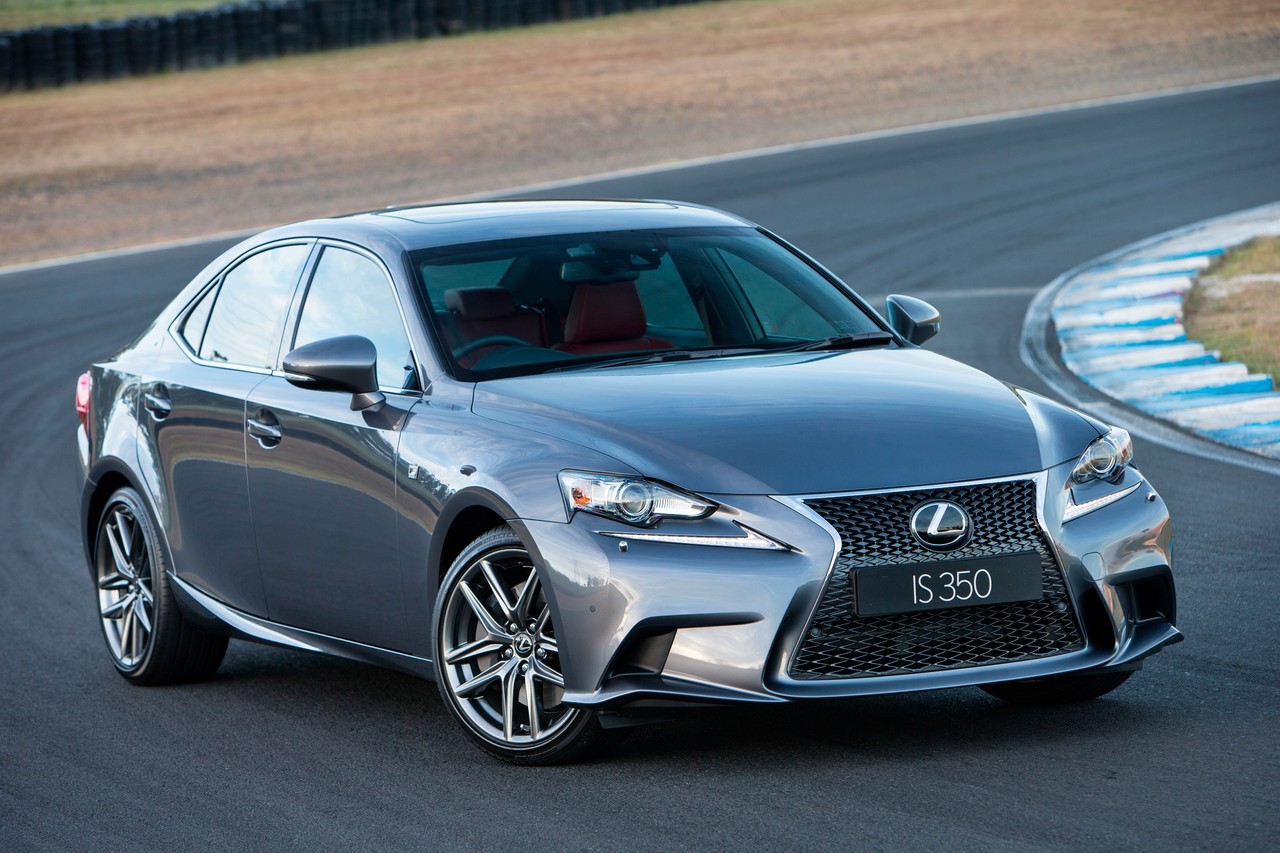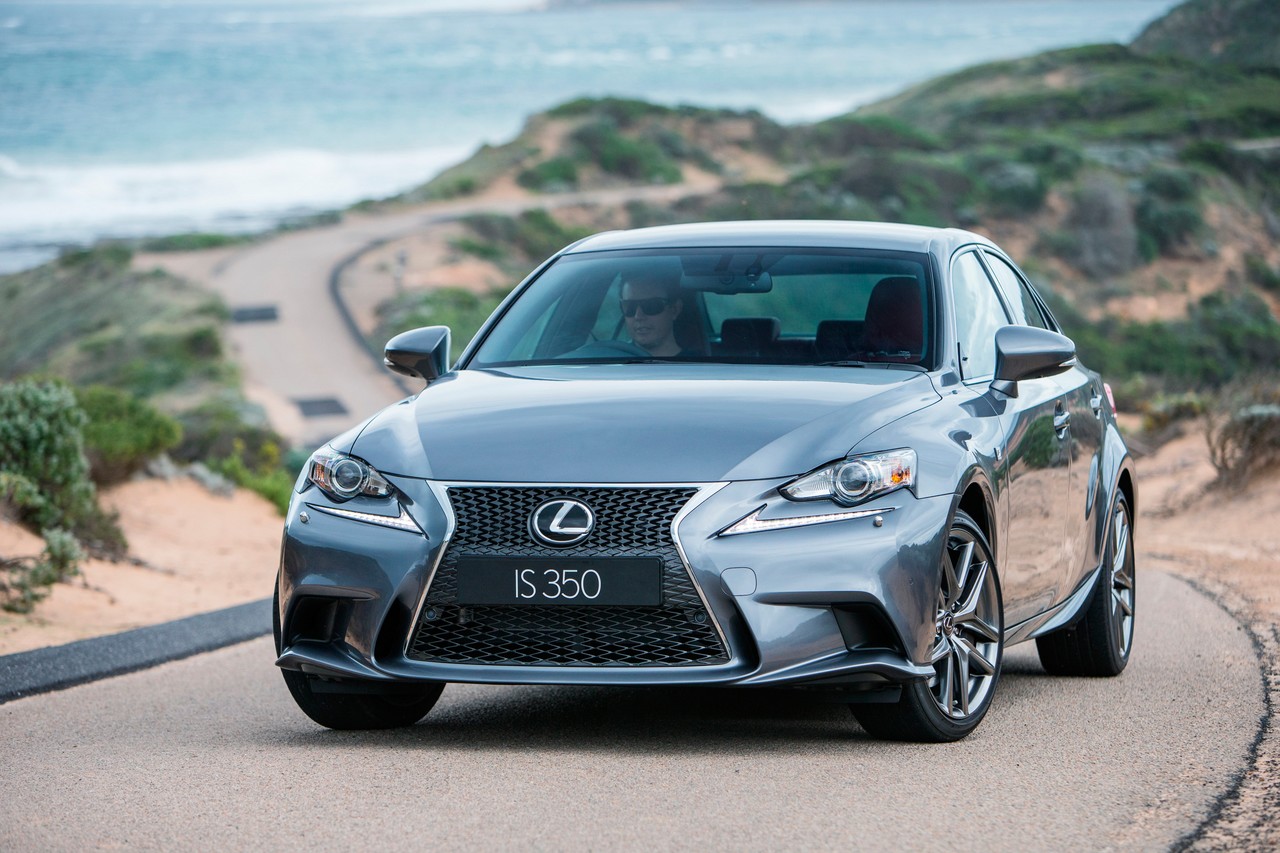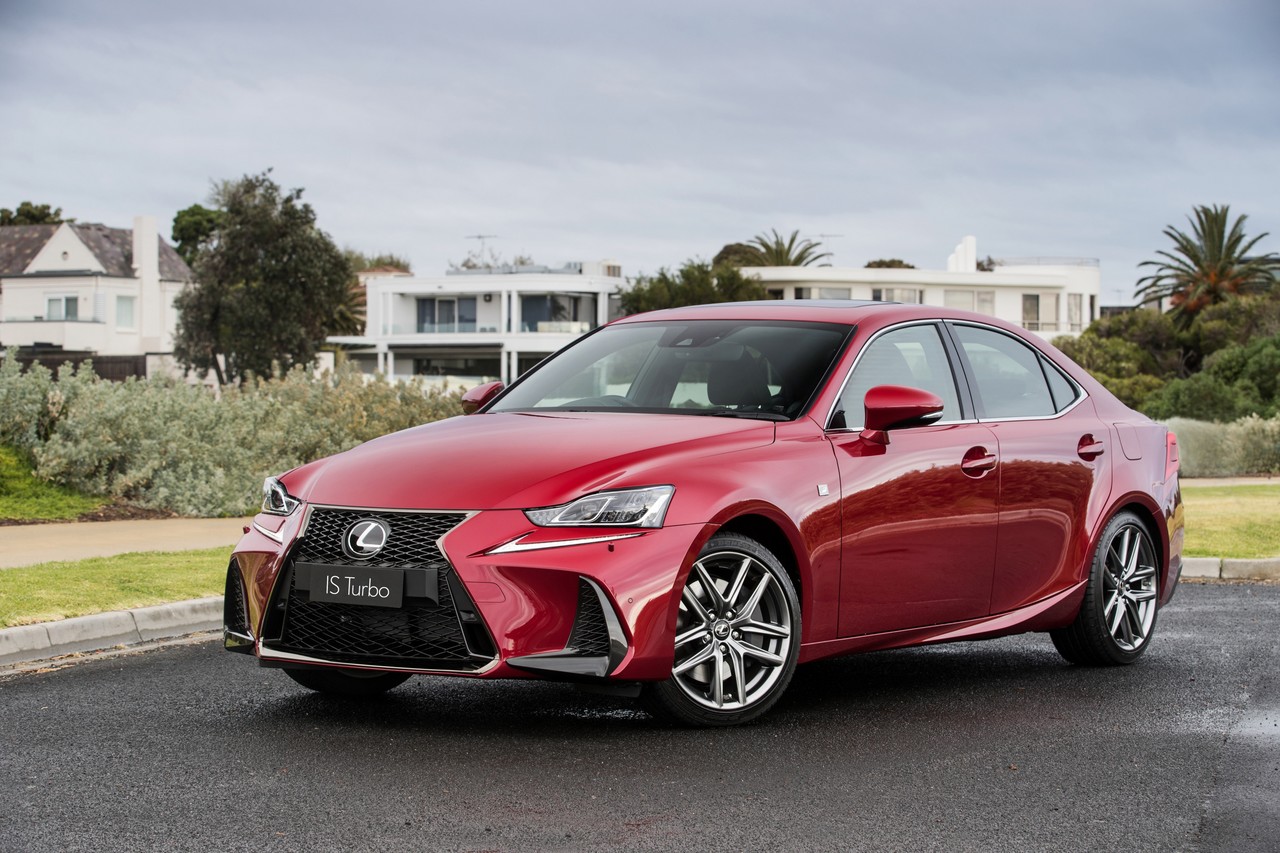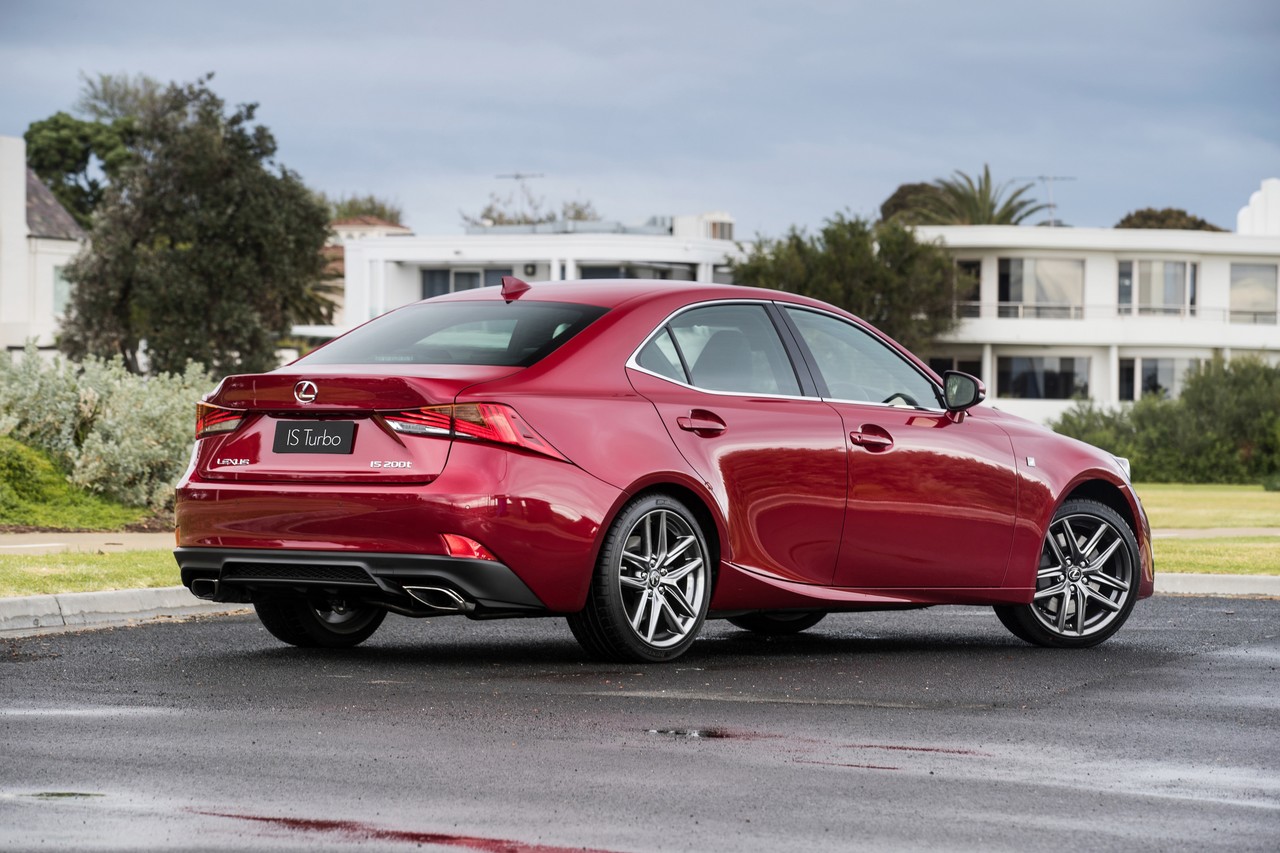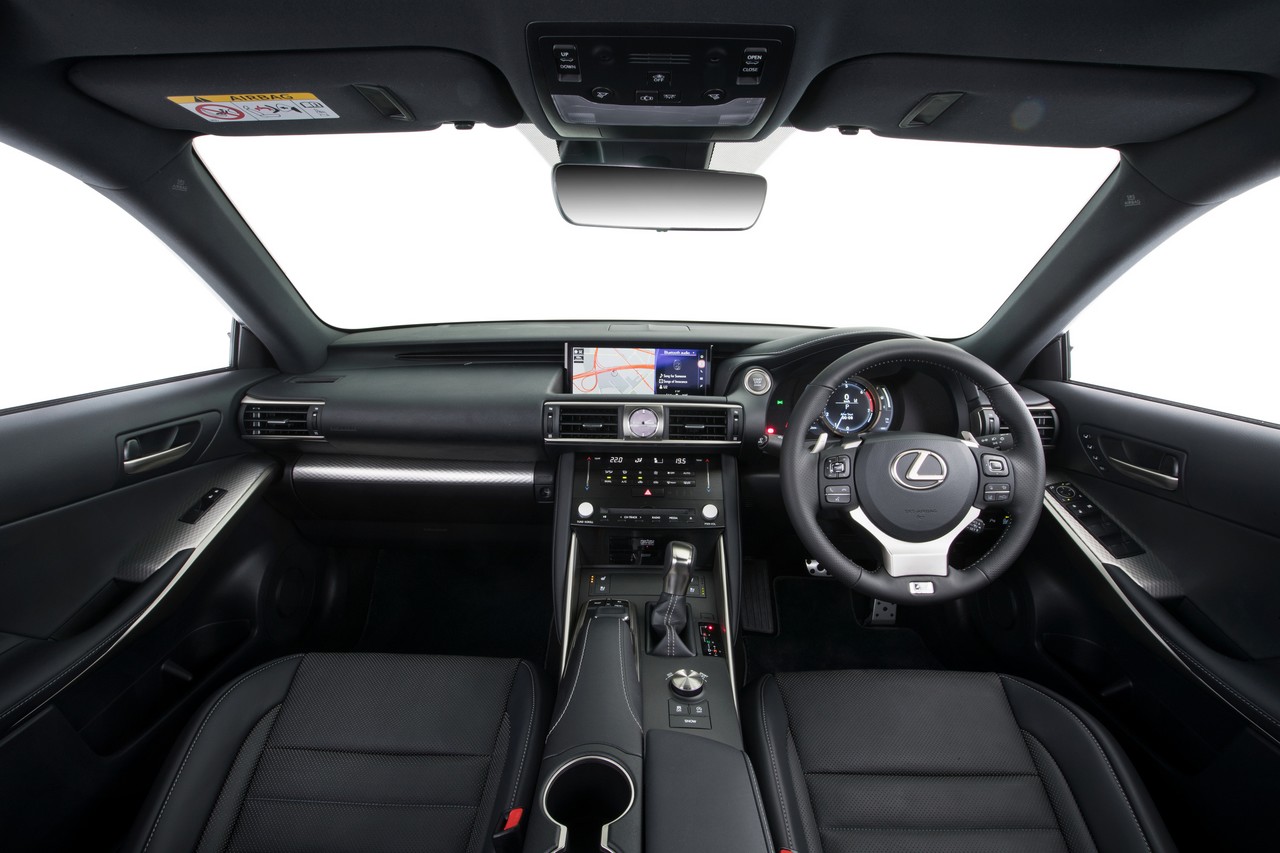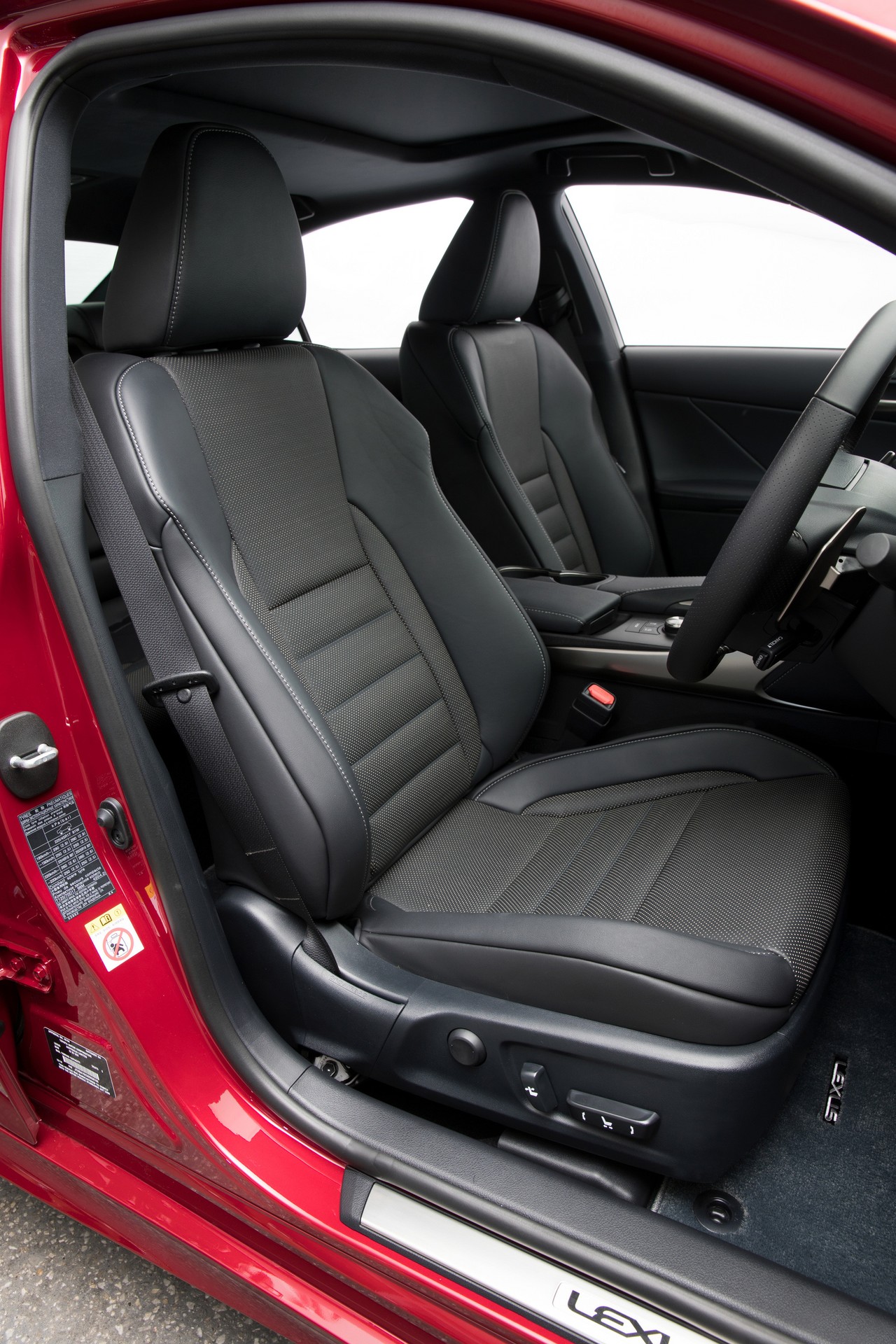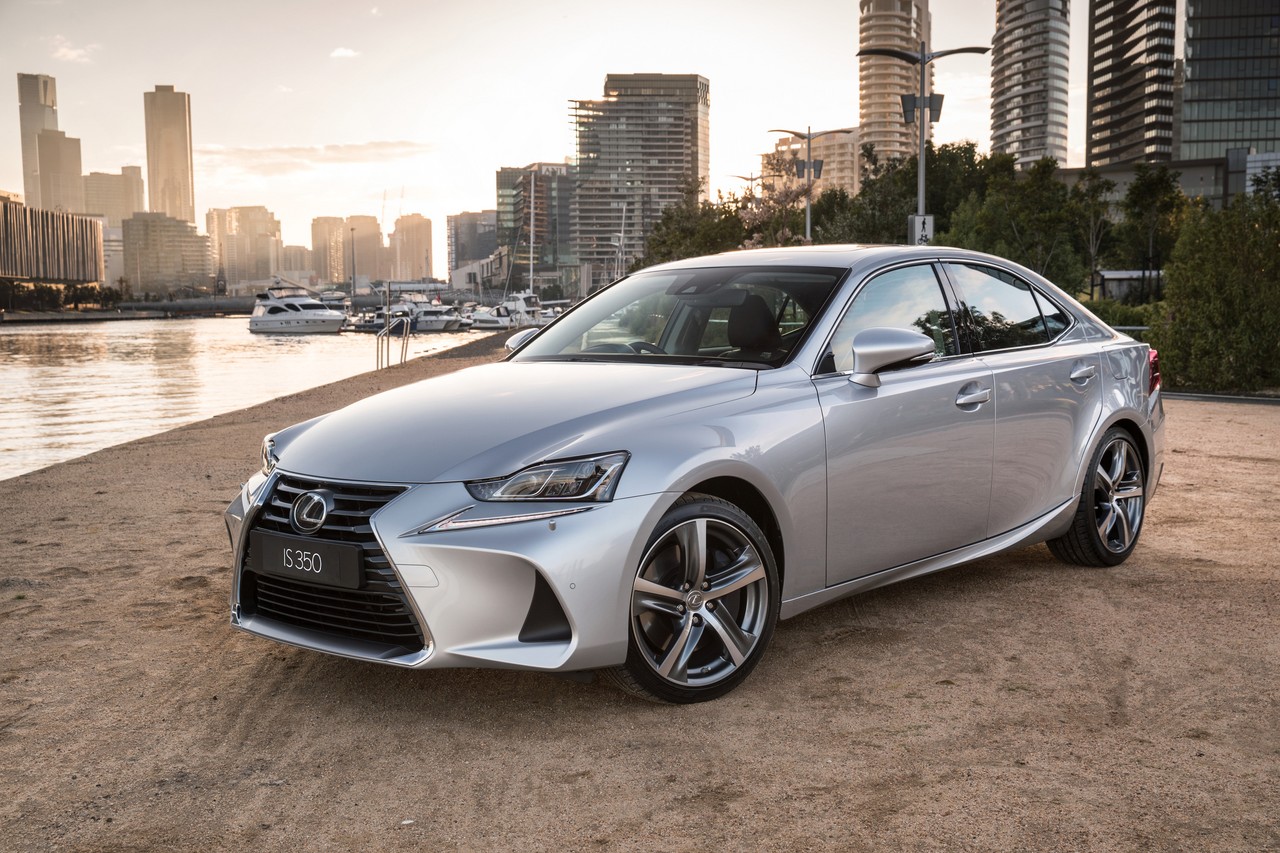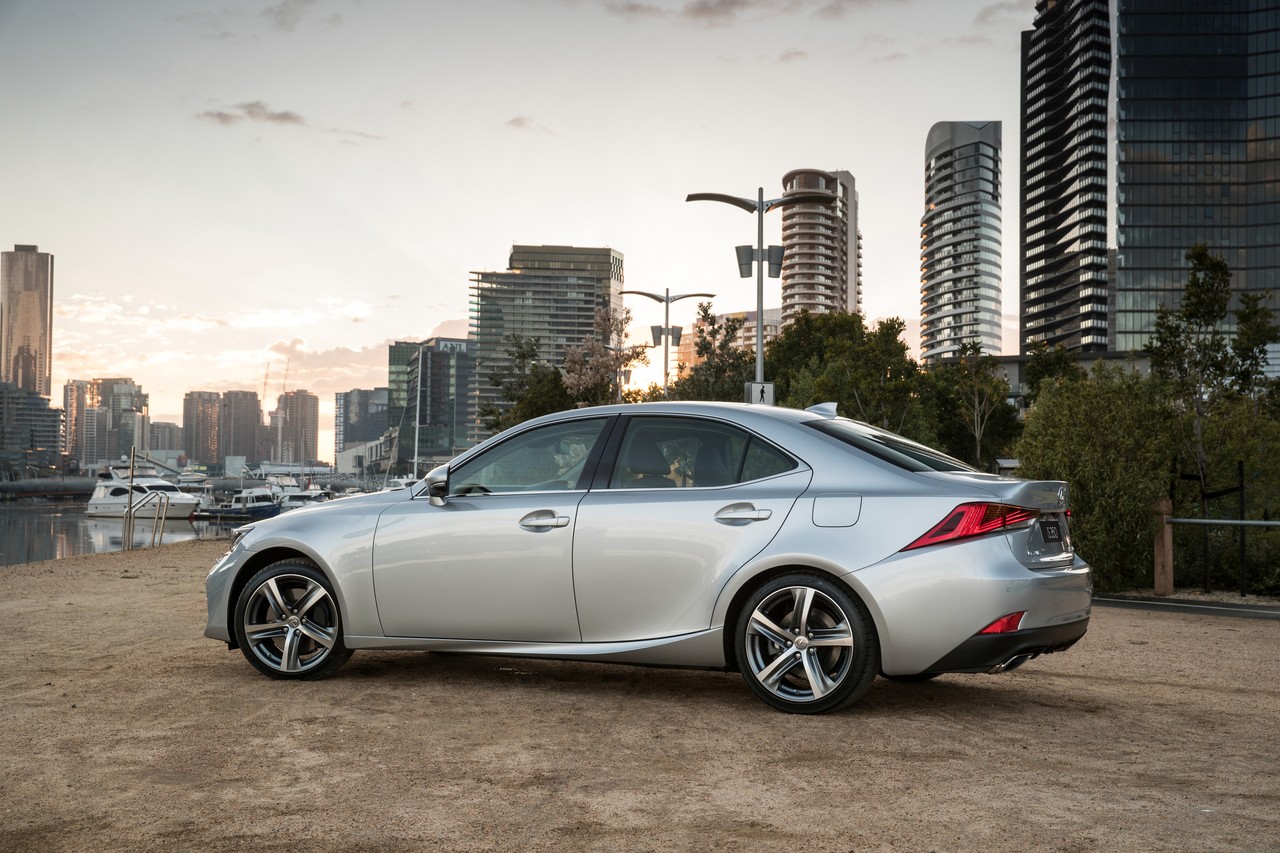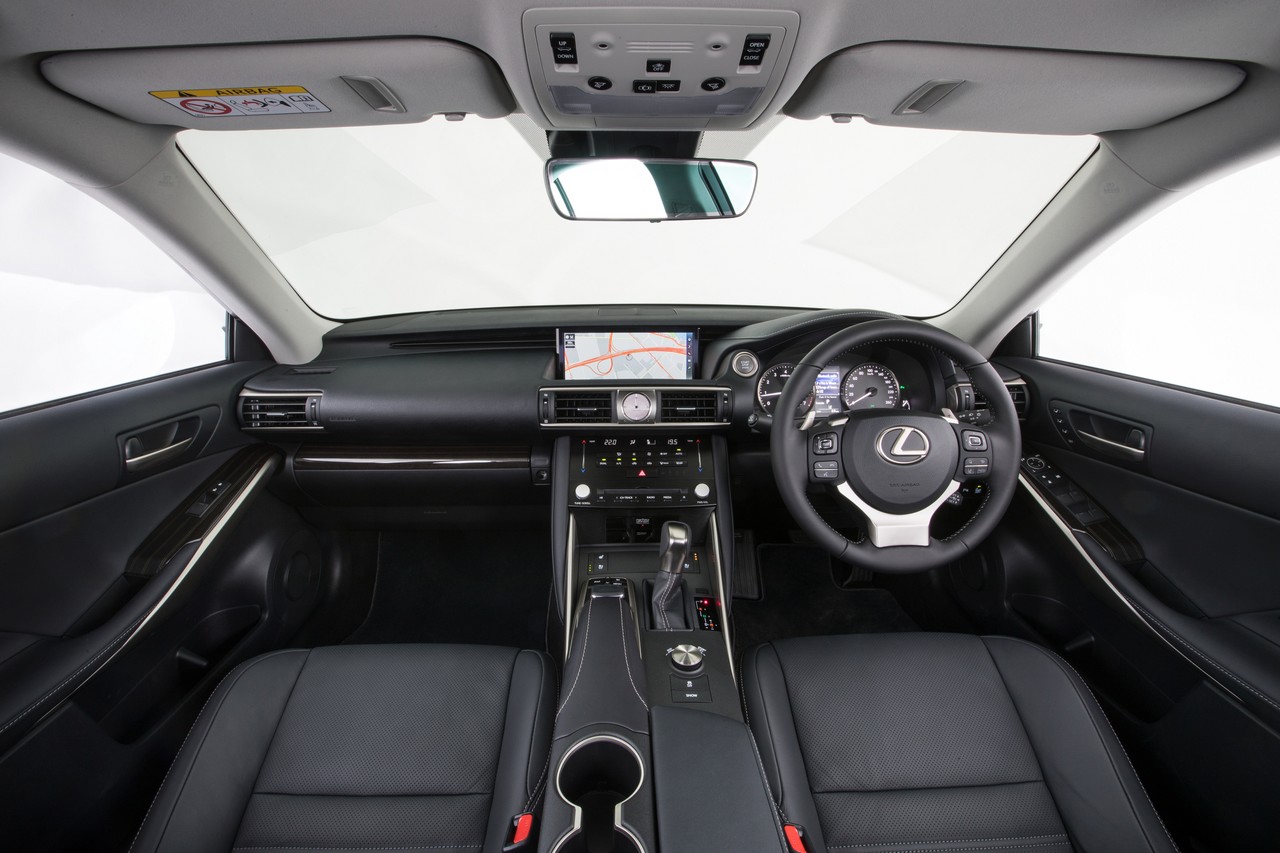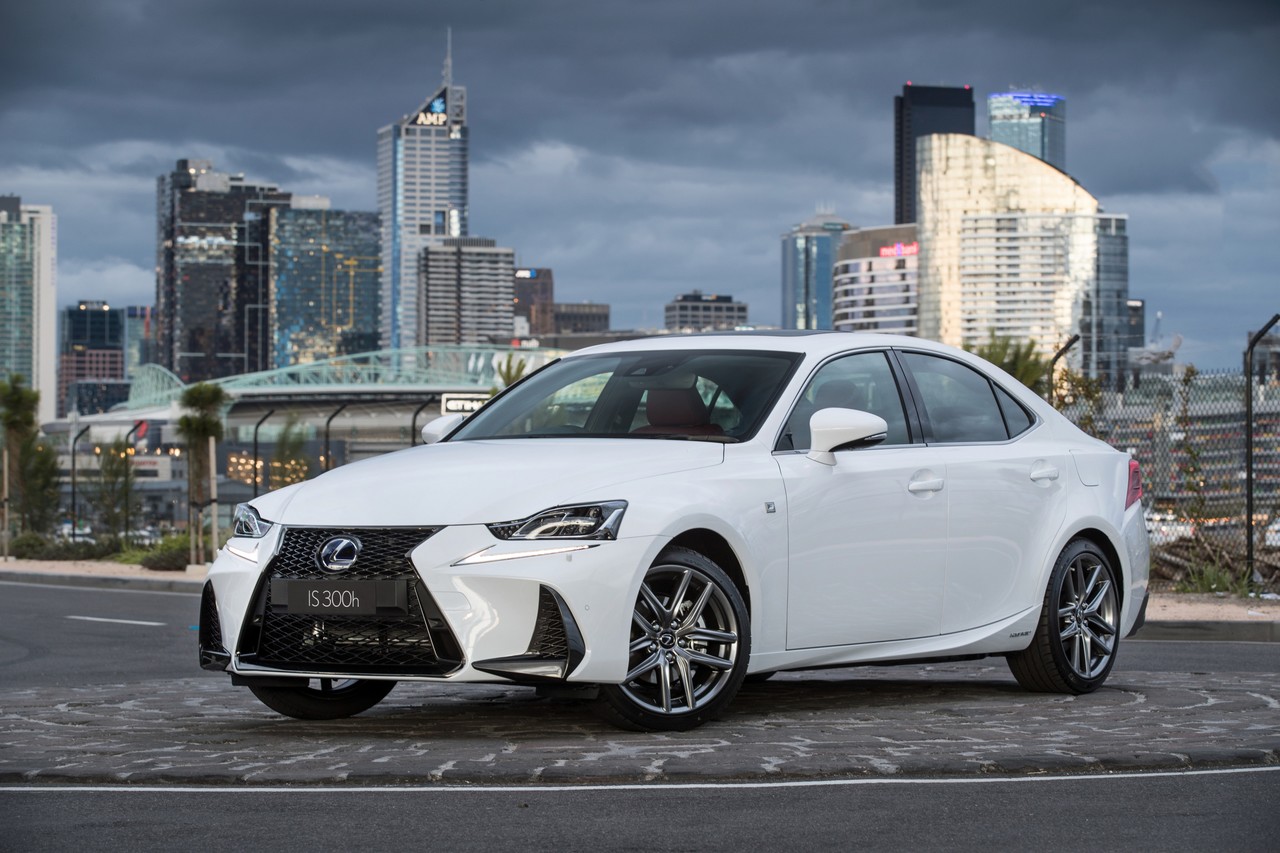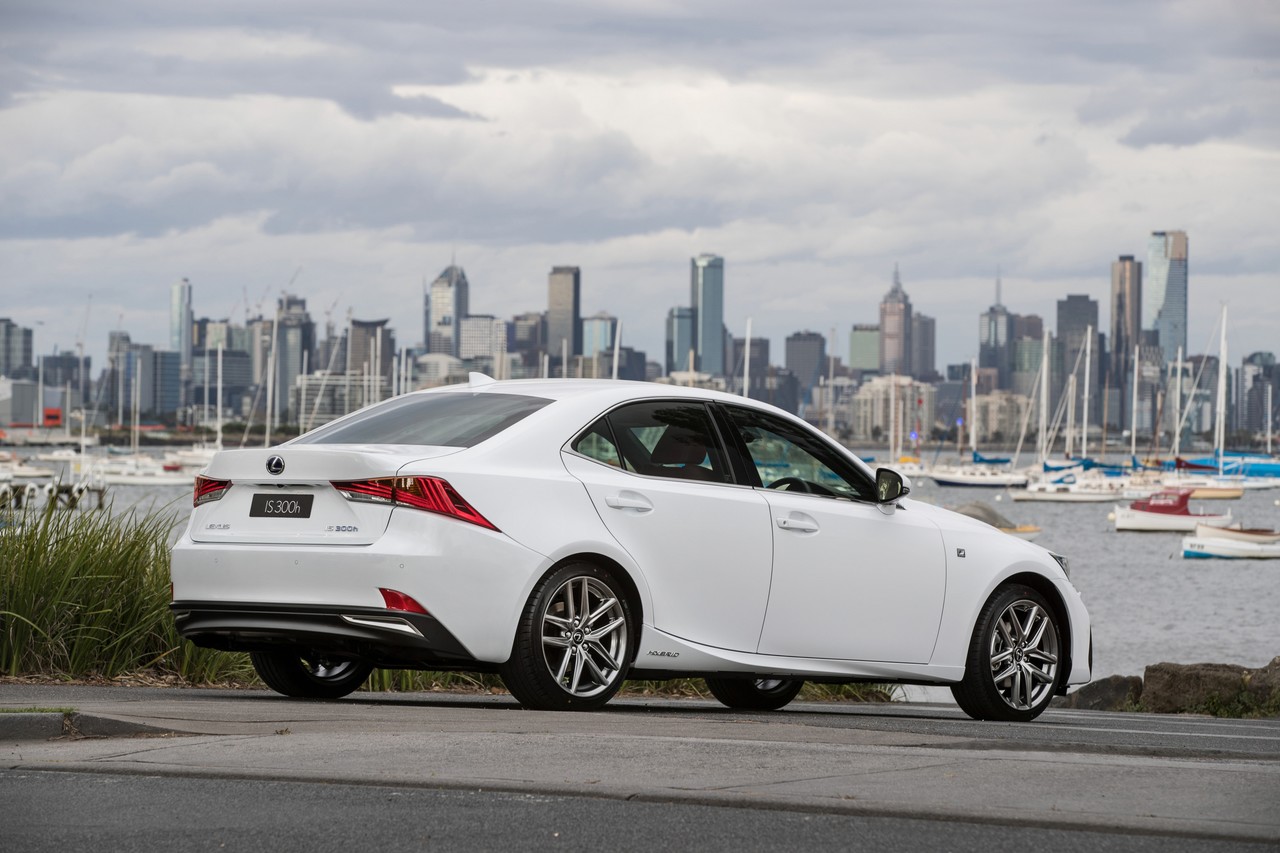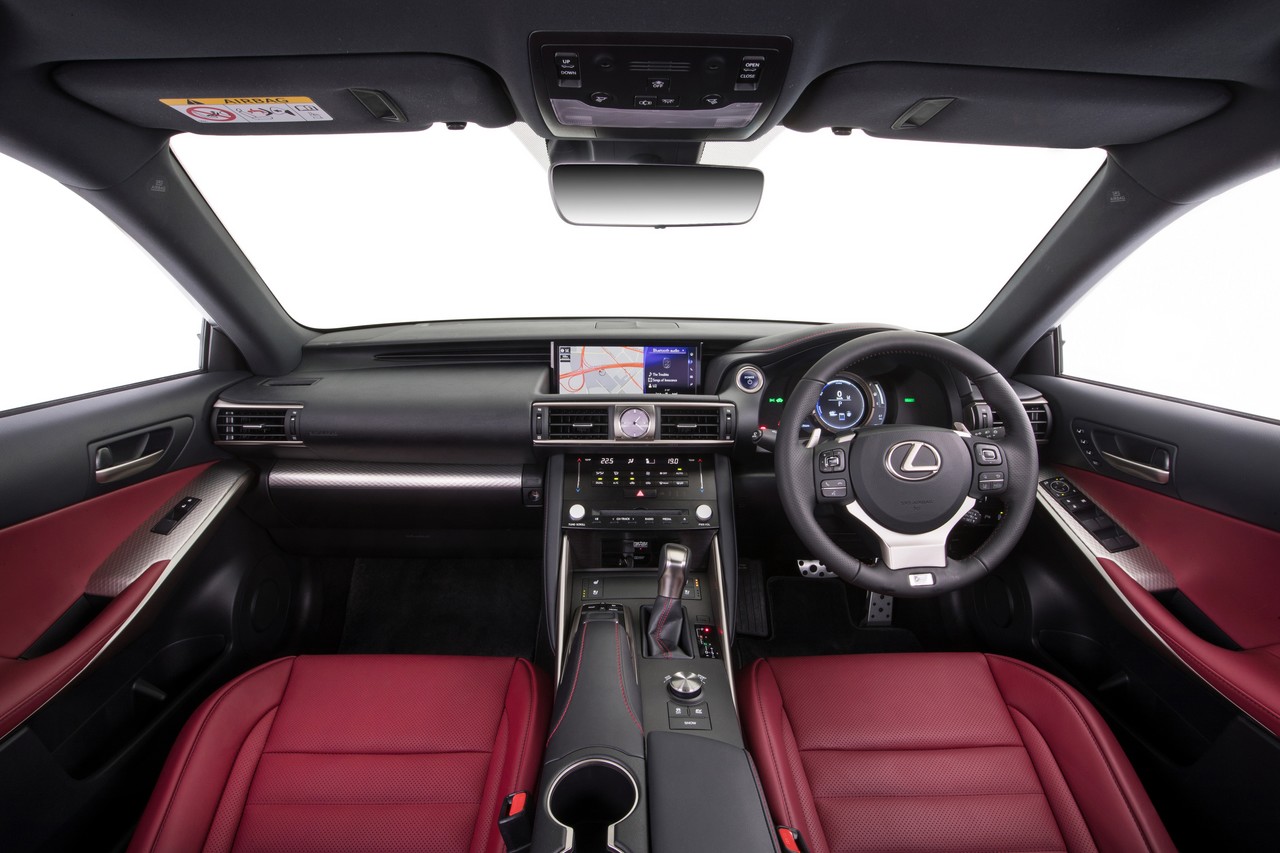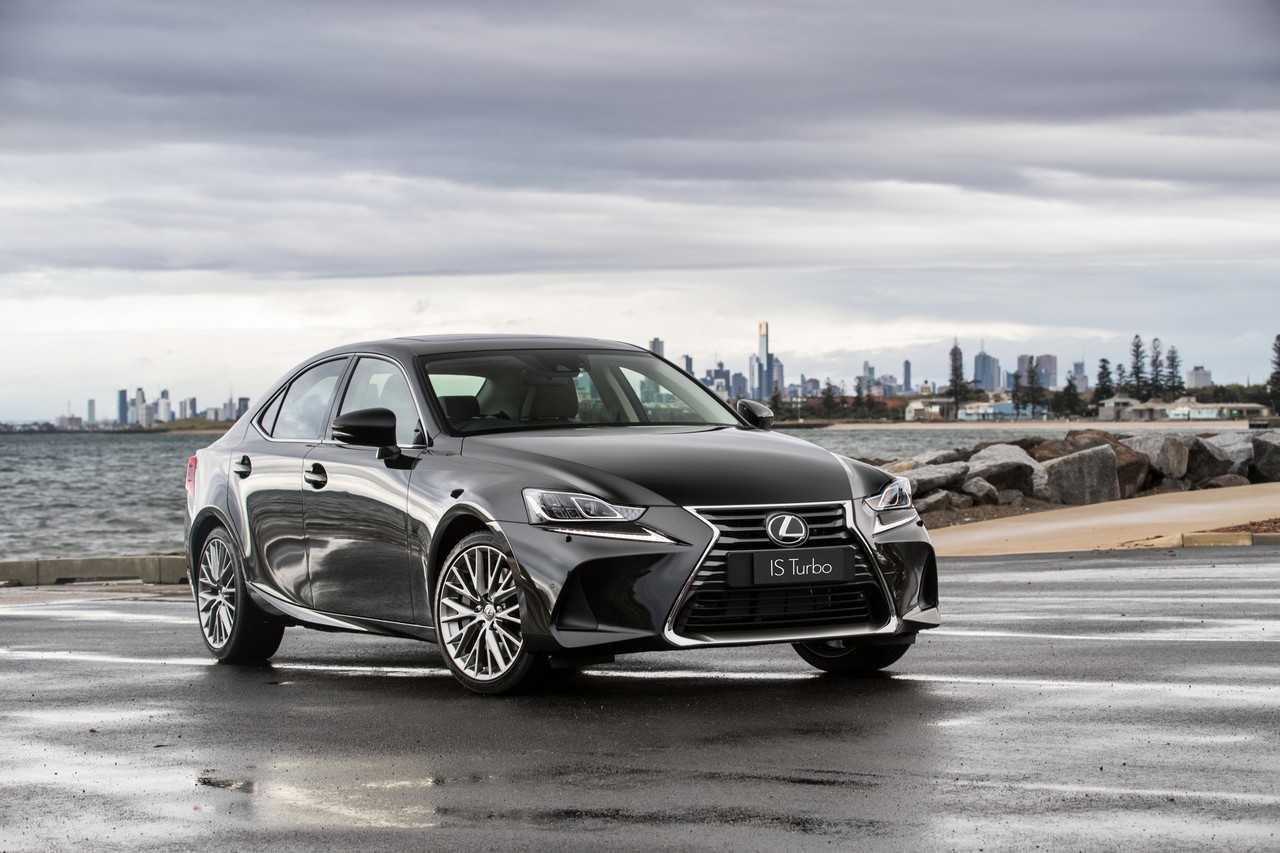
- For IS 300h, refined hybrid powertrain
- Accomplished ride/handling balance
- Supportive front seats
- High standard of interior fit and finish
- Steering is direct…
- … but lacks feel of rivals
- For IS 250, 2.5-litre V6 engine and six-speed transmission not at fuel efficient as rivals
- Cramped rear seat
- Early ESC intervention
- For IS 300h, whine from the CVT
Review: Lexus XE30.I IS (2013-16)
Overview
Released in July 2013, the Lexus XE30 IS was a compact executive sedan. Manufactured in Japan, the rear-wheel drive IS range initially consisted of the IS 250, IS 350 and IS 300h models, available in Luxury, F Sport and Sports Luxury variants. In September 2015, however, the IS 250 was replaced by the IS 200t.
Engines: 4GR-SR, 2GR-SE, 8AR-FTS and 2AR-FSE
Of the engines,
- The IS 250 was powered by the 2.5-litre 4GR-FSE V6 engine which had direct-injection, double overhead camshafts (per cylinder bank), four valves per cylinder, variable intake and exhaust valve timing (dual VVT-i), an electronically-controlled acoustic induction system (ACIS) and a compression ratio of 12.0:1;
- For the IS 350, the 3.5-litre 2GR-FSE engine had similar specifications to the 4GR-FSE , but simultaneously combines direct injection with traditional port injection for more precise air/fuel mixing under low and medium load conditions. Furthermore, ACIS is omitted and the compression ratio is reduced to 11.8:1. The IS 350 was fitted with an eight-speed AA81 automatic transmission which provided faster gear changes, full torque converter lock-up and throttle blips in manual mode;
- For the IS 200t, the 2.0-litre 8AR-FTS turbocharged petrol engine has an aluminium block and aluminium cylinder head, direct and port injection (Toyota’s ‘D-4S’), a twin-scroll turbocharger (which provided maximum boost pressure of 17 psi or 1.17 bar), an integrated exhaust manifold, double overhead camshafts and four valves per cylinder. While the exhaust valves had standard variable valve timing (Variable Valve Timing with Intelligence, or ‘VVT-i’), the intake valves had a mid-position camshaft lock mechanism which retarded the continuously variable valve timing, known as Variable Valve Timing-intelligent Wide (VVT-iW). The ability to retard intake valve timing enabled the engine to use an Atkinson cycle for low-rev operations to minimise fuel consumption and an Otto cycle at higher engine speeds for greater power. The 8AR-FTS engine also featured a ‘stop-start’ system which enables it to shut down when the vehicle is stationary in traffic; and,
- The IS 300h hybrid powertrain included:
- A 2.5-litre 2AR-FSE Atkinson cycle four-cylinder petrol engine with double overhead camshafts (DOHC), D-4S direct injection, variable intake and exhaust valve timing (dual VVT-i), exhaust gas recirculation, a compression ratio of 13.0:1;
- A water-cooled, 650-volt permanent magnet electric motor which drew power from nickel metal hydride (Ni-MH) batteries positioned under the luggage deck board; and,
- A continuously variable L210 transmission with six pre-set ratios that could be selected via steering wheel gearshift paddles.
| Variants | Motor | Trans. | Peak power | Peak torque | |
|---|---|---|---|---|---|
| IS 250 | Luxury, F Sport, Sports Luxury |
2.5-litre petrol V6 (4GR-FSE) | 6sp auto | 153 kW at 6400 rpm | 252 Nm at 4800 rpm |
| IS 200t | N/A | 2.0-litre turbo petrol I4 (8AR-FTS) | 8sp auto | 180 kW at 4800-5600 rpm | 350 Nm at 1650-4000 rpm |
| IS 300h | Luxury, F Sport |
2.5-litre petrol I4 (2AR-FSE) | CVT (6 pre-set ratios) |
133 kW at 6000 rpm | 221 Nm at 4200-5400 rpm |
| Electric motor | 105 kW | 300 Nm | |||
| Combined | 164 kW | N/A | |||
| IS 350 | Luxury, F Sport, Sports Luxury |
3.5-litre petrol V6 (2GR-FSE) | 8sp auto | 233 kW at 6400 rpm | 378 Nm at 4800 rpm |
Dimensions
Compared to the Lexus XE20 IS , the XE30 IS was 75 mm longer (at 4665 mm), 10 mm wider (1810 mm), 5 mm taller (1430 mm) and had a 70 mm longer wheelbase (2800 mm). The XE30 IS body also achieved a 10 per cent increase in overall rigidity due to the use of high-tensile strength steel, laser screw welding, adhesive body bonding techniques and additional spot welding.
Steering and suspension
The Lexus XE30 IS had electric power steering, double wishbone front suspension (previously MacPherson struts) and independent, multi-link rear suspension (its design shared with the Lexus L10 GS ). Furthermore, Sports Luxury and F Sport variants were fitted with Adaptive Variable Suspension (AVS) suspension systems with variable damping.
Safety equipment
Standard safety equipment for the Lexus XE30 IS included dual front airbags, dual front knee airbags, front side airbags, full-length curtain airbags, ABS, electronic brake force distribution, brake assist, electronic stability control, traction control, front seatbelts with pretensioners and load limiters and a pop-up bonnet which could reduce the severity of injury to pedestrians in the event of a front-end collision.
The Lexus IS F Sport and Sports Luxury variants were further equipped with a blind spot monitoring system which – at speeds above 40 km/h – used radar sensors to detect vehicles in adjacent lanes and warn the driver via LED indicators in the door mirrors.
Lexus IS Sports Luxury variants were also fitted with rear side airbags, Lexus’ Pre-Collision Safety (PCS) system with Pre-Collision Brake function, adaptive cruise control and a Lane Departure Warning.
From October 2014, the F Sport and Sports Luxury variants were both equipped with a Rear Cross Traffic Alert (RCTA) system; RCTA was also made available for the IS 300h Luxury as part of the optional, extra-cost Enhancement Packs 2 and 3.
In September 2015, Lexus’ Pre-Collision Safety System and adaptive cruise control were made standard across the range (i.e. added to the Luxury and F Sport variants, having previously been limited to the Sports Luxury). Furthermore, rear-seat side airbags were also fitted as standard such that each Lexus IS vehicle was fitted with ten airbags.
Brakes
The Luxury and Sports Luxury variants had 296 mm by 28 mm ventilated front brake discs and 290 mm by 10 mm solid rear discs. F Sport variants, however, had 334 mm by 30 mm ventilated front brake discs and 310 mm by 18 mm ventilated rear discs.
Euro NCAP testing
In Euro NCAP testing , the Lexus XE30 IS 300h received a five star safety rating which included a 91 per cent adult occupant protection rating and an 85 per cent child occupant protection rating. In the offset crash test, occupant protection for the driver’s head and upper legs was assessed as good, though chest, lower leg and foot protection was rated as adequate. Maximum points were awarded in the side impact test; in the more severe pole test, however, chest protection was also rated as adequate.
Under ANCAP’s methodology , this testing resulted in a five star adult occupant protection rating with a score of 35.0 out of 37.
Features: Lexus IS Luxury, F Sport and Sports Luxury
Standard features for the Lexus XE30 IS Luxury variants included 17-inch alloy wheels with 225/45 R17 tyres, an eight speaker Pioneer sound system with digital radio (DAB+), auxiliary inputs (3.5 mm/USB/iPod) and Bluetooth connectivity, satellite navigation with a seven-inch colour touchscreen, dual-zone climate control air conditioning, heated and ventilated front seats, power adjustable front seats, leather upholstery, cruise control, bi-xenon headlights, daytime LED running lights, a reversing camera, 60/40 split and folding rear seats, a leather-wrapped steering wheel, remote central locking with proximity key, power windows and folding mirrors, tilt and telescopic steering wheel adjustment, a trip computer and an immobiliser.
From September 2015, the Lexus IS Luxury also had a power adjustable steering wheel.
The IS F Sport variants were further equipped with 18-inch alloy wheels with 225/40 R18 front and 255/35 R18 rear tyres, front and rear parking sensors and a power adjustable steering wheel. Unique with the range, the F Sport variants had contoured sports seats (with ‘integrated foaming’ construction), TFT instrumentation and black felt roof lining. Visually, the F Sport variants could be identified by their unique front and rear bumpers, side skirts, grille, ten-spoke alloy wheels and badging.
While the Luxury variants had three selectable drive modes – Eco, Normal and Sport – the F Sport and Sports Luxury variants replaced the latter with Sport S and Sport S+ modes.
The range-topping IS Sports Luxury variants were distinguished by their 835 watt Mark Levinson surround sound system with 15 speakers, automatic high-beam headlights, power-operated sunblind and ‘Lexus Park Assist’ system with parallel parking and perpendicular parking modes.
From late 2013, the IS was available with Lexus’ ‘Enform’ telematics system.
October 2014 update
From October 2014, the Luxury and Sports Luxury models were fitted with LED fog lamps as standard. For the IS 300h, 18-inch alloy wheels were made available as part of the optional, extra-cost Enhancement Packs 2 and 3 and a new hybrid badge design was introduced.
Across the range, interior trim was updated and new silver highlights were introduced for the air vents, clock, centre register, door trim and steering wheel; a new ‘Moonstone’ leather-accented trim was also introduced, replacing light grey. Finally, the Lexus Remote Touch (LRT) system was updated to be easier to use.
Brochures
- Brochure: Lexus XE30 IS (May 2013)
- Brochure: Lexus XE30 IS (January 2014)
- Brochure: Lexus XE30 IS (March 2016)
Related links
- Press Kit: Lexus XE30 IS (July 2013)
- Lexus Australia: IS, ES and CT updates (October 2014)
- Lexus Australia: 2015 Lexus IS 200t (September 2015)
Review: Lexus XE30.II IS 200t, IS 300h and IS 350 (2016-21)
Overview
Released in Australia in November 2016, the Lexus XE30 Series II (XE30.II) IS range consisted of the IS 200t, IS 300h and IS 350 models. Visually, the Lexus XE30.II IS could be identified by its 15 mm longer front bumper with ‘evolved’ spindle grille, new LED headlamps that extended further inward, new daytime running lamps, new rear combination lamps with the indicator lamps moved to the inside and lower rear bumper.
Inside, the Lexus XE30.II introduced a larger 10.3-inch display audio screen (replacing the seven-inch unit) in the centre of the dashboard, an improved Lexus Remote Touch controller, new trim colours and combinations, longitudinal stitching across the cockpit fascias and new instrument gauges that incorporated a non-lineal scale beneath 100 km/h on the speedometer for easy recognition.
For the chassis, changes included ‘revised upper suspension support characteristics’ and a new aluminium front lower suspension arm and bushing.
| Variants | Motor | Trans. | Peak power | Peak torque | |
|---|---|---|---|---|---|
| IS 200t | Luxury, F Sport, Sports Luxury |
2.0-litre turbo petrol I4 (8AR-FTS) | 8sp auto | 180 kW at 4800-5600 rpm | 350 Nm at 1650-4000 rpm |
| IS 300h | Luxury, F Sport, Sports Luxury |
2.5-litre petrol I4 (2AR-FSE) | CVT (6 pre-set ratios) |
133 kW at 6000 rpm | 221 Nm at 4200-5400 rpm |
| Electric motor | 105 kW | 300 Nm | |||
| Combined | 164 kW | N/A | |||
| IS 350 | Luxury, F Sport, Sports Luxury |
3.5-litre petrol V6 (2GR-FSE) | 8sp auto | 233 kW at 6400 rpm | 378 Nm at 4800 rpm |
Safety equipment
As standard, the Lexus XE30.II IS was equipped with the Lexus Safety System+ (LSS+) which included –
- Lexus’ Pre-Collision Safety System (PCS) with Autonomous Emergency Braking (AEB): could anticipate frontal collisions, warn the driver and prepare the braking system. AEB operated at vehicle speeds between 15 km/h and 180 km/h, and where there was a speed difference with the vehicle ahead that exceeded 10 km/h. On F Sport and Sports Luxury variants, PCS interacted with the Adaptive Variable Suspension (AVS) to ‘maintain appropriate vehicle posture under heavy braking’ provided 1) vehicle speed was between 30 km/h and 180 km/h, and 2) the relative speed of the other vehicle was more than 30 km/h;
- Lane Departure Warning+ (LDW+): if the Lexus IS was about to move out of its lane without the turn indicator having been applied, LDW+ would alert the driver by sounding a buzzer, vibrating the steering wheel and illuminating a warning on the multi-information display. If the vehicle continued to move outside the lane, light steering force would be applied to bring the vehicle back on course – this function was denoted by the ‘+’ symbol in LDW+;
- Active Cruise Control (ACC); and,
- Automatic High-Beam (AHB) headlamps.
As per the post-October 2014 Lexus IS range, the F Sport and Sports Luxury variants were further equipped with a Blind Spot Monitor and Rear Cross Traffic Alert function.
Features: Lexus XE30.II IS
Standard features for the Lexus XE30.II IS Luxury variants were extended to include a ten speaker Pioneer sound system, 10.3-inch multimedia display and LED headlamps (a single LED low/high beam headlamp and bulb-type turn-signal lamp). Visual cues for the Lexus XE30.II IS Luxury included 17-inch bright-finish alloy wheels with a new design and dual trapezoidal exhaust tips.
The Lexus XE30.II F Sport was distinguished by its Naguri-style aluminium ornamentation, Smart Key Card. Visual cues for the F Sport included 18-inch alloy wheels with a ‘dark premium metallic’ finish, ‘3L’ LED headlamps (a three-lamp low beam system, separate LED high-beam lamp and LED turn signal lamps), and unique ‘F Sport’ treatment for the grille, steering wheel and scuff plates.
The range-topping Lexus IS Sports Luxury was distinguished by its Mark Levinson audio system with fifteen speakers, a moon roof and laser-cut wood ornamentation.
Brochure
Related links
- Lexus Australia: 2016 Lexus IS Line – Press Kit
- Wikipedia.org: Lexus XE30 IS
- Behind the Wheel: 2017 Lexus IS 200t and IS 350 Review

